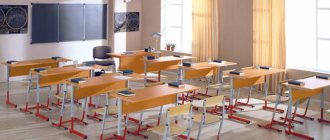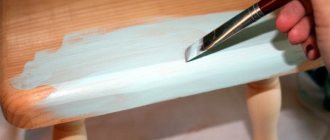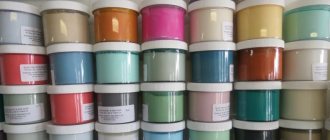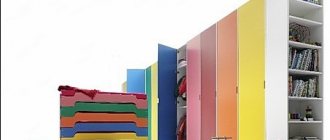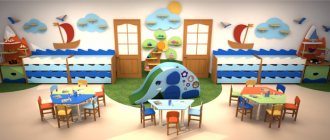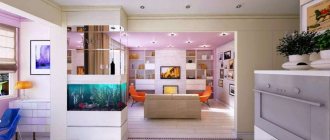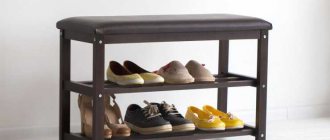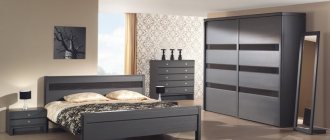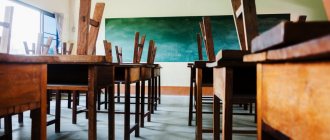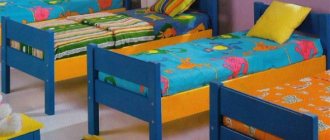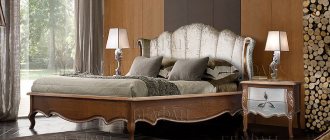School furniture
is the main element in organizing the educational process. To make the learning process more effective, it must be convenient, safe and multifunctional. The production of school furniture should involve the use of modern technologies and equipment that meets all the best international requirements. This is a high-tech and knowledge-intensive process. Recently, in order to increase the effectiveness of learning, it is simply necessary to select school furniture correctly and competently.
After all, the health of the child, the correctness of his posture and the general condition of the spine depend on this. After all, it is the spine that suffers from uncomfortable posture and excessive stress. It is extremely important that children sit on comfortable chairs, at wide, comfortable desks where all textbooks and notebooks can be placed. After all, if the child is comfortable, then he will not be distracted from the educational process.
Types of school furniture
Each classroom must be equipped in accordance with SanPiN standards. A standard set of furniture in a classroom or student auditorium includes:
- desks;
- chairs;
- teacher's desk;
- cabinets for storing educational materials and aids.
Depending on the area and purpose of the office, its equipment may vary. There are several main types of classrooms:
- audiences and classes;
- subject classes that require the placement of visual aids, as well as special tables for conducting experiments and laboratory work (physics, chemistry, biology and geography classrooms);
- teachers' rooms or rooms for teachers;
- assembly halls;
- libraries;
- dining rooms
There are a number of general requirements for school furniture. Conventionally, they can be divided into the following groups:
- Pedagogical. Furniture for a physics and chemistry classroom will differ in its configuration from the desks and tables for regular school classrooms. It is important to take into account the specifics of the classroom. Some require cabinets with spacious niches for visual aids or equipment (microscopes, flasks, etc.).
- Sanitary and hygienic. The material and coating of student furniture for school must be safe, non-toxic and resistant to different temperatures. Also, countertops should be smooth and well-finished so that there is no risk of injury. Delamination of wood on chairs and desks is excluded, as this can lead to splinters and other injuries. It is important to replace furniture damaged during long-term use as soon as possible.
- Ergonomic. All student furniture should be comfortable and safe to use. To do this, it is necessary to take into account the average weight and height of students of a certain age group, and depending on this, select the height and size of the working surface of the desk. Also, for safety, the corners of the desks are made beveled or rounded. In addition, a plastic edge is used around the perimeter of the tabletop. The frame is made stable so that the desks do not wobble even on uneven surfaces. Ergonomic requirements also include the distance at which desks are located between each other and from the board. The width of the aisles between rows of desks must be at least 60 cm, and the board must hang at a distance of 2.4 m from the first desk.
- Durability requirements. The better and more durable the furniture for the school, the less often you will have to update the classroom stock. This will reduce the economic burden and allow you to immediately replace failed interior items.
- Architectural and artistic. Student furniture should be aesthetic and modern, and also be combined with other interior items in the classroom. With the help of furniture, you can create a harmonious atmosphere in the classroom, in which it will be comfortable to conduct classes.
This is interesting: Variety of wardrobes for children's rooms, reasons for their popularity
Equipment
By the end of 2022, all classrooms in Russian educational institutions must be equipped with devices that disinfect the air (SP 3.1/2.4.3598-20 “Sanitary and epidemiological requirements for the design, content and organization of work of educational organizations and other social infrastructure facilities for children and youth in spread of the new coronavirus infection (COVID-19)." The rest of the SanPiN standards remained the same.
Business Solutions
- the shops
clothes, shoes, products, toys, cosmetics, appliances Read more
- warehouses
material, in-production, sales and transport organizations Read more
- marking
tobacco, shoes, consumer goods, medicines Read more
- production
meat, procurement, machining, assembly and installation Read more
- rfid
radio frequency identification of inventory items More details
- egais
automation of accounting operations with alcoholic beverages Read more
- The gloss of the coating is no more than 49%.
- The working surface is easy to clean from dirt. Science classroom tables are equipped with a protective layer against chemicals.
- Compliance with all epidemiological standards.
Furnished products for student use must have the following parameters:
The dimensions of educational furniture and its marking at school (according to SanPiN) are far from the only conditions that must be met. Requirements are also put forward for assembly:
- Reliable fixation of all structural parts.
- Impossibility of manually separating hardware elements.
- The absence of any irregularities on the outer surface. Sharp edges are rounded and holes in metal pipes with a diameter greater than 7 mm are closed or hidden.
- Contaminating parts are hidden.
GOST 22360-95 regulates the proper fixation of large objects:
- A strong and immovable connection of all parts of the structure and the impossibility of disassembling it manually.
- Reliable fastening of the stand (if available) to the object.
Furniture used in educational institutions must have special markings, which are indicated in Russian or the official regional language. It is prohibited to make any marks on the work surface. Tables are marked using special colored stickers that correspond to the height categories of GOST 11015 and 11016.
Board
The study board should also be studied. New sanitary and epidemiological standards and hygiene rules affected:
- chalkboard lighting;
- location and diagonal of the interactive whiteboard;
- the viewing angle remained the same, however, due to recent updates, this standard applies not only to three-meter boards.
The requirements regarding the marker board remain unchanged.
Desk number (according to Sanitary Regulations) and the size of educational furniture according to the student’s height, table
Experts have developed a size table that provides for the division of furniture into 6 groups. Such a classification makes it possible to differentiate it depending on the growth of children, thanks to which they can sit safely and comfortably at tables without damaging their eyesight or posture while doing any work (reading, writing, drawing and much more).
Legal requirements
The technology requirements are set out in the regulatory document GOST 22046-2016 “Furniture for educational institutions. General technical conditions", which is an interstate standard for Russia, approved by the Interstate Council for Standardization, Metrology and Certification on December 19, 2016.
The general requirements correspond to the state standard. A unified documented regulation allows for the mass purchase of student furniture for schools in all regions of Russia. All products undergo strength tests in accordance with the prescribed documentation.
School furniture according to GOST 22046-2016 must have the following parameters:
- The gloss of the coating does not exceed the permissible 49%.
- The surface is easy to clean. Science classroom tables are equipped with protection against reagents.
- The work surface meets current durability standards.
Requirements for assembling school furniture sets:
- All structural elements are securely fixed.
- Hardware parts cannot be separated by hand.
- Any unevenness on the exterior of furniture is unacceptable. Sharp edges should be rounded. The openings of metal pipes with a diameter greater than 7 mm are closed or hidden.
- Staining elements are hidden.
Proper fixation of large furniture is regulated by GOST 22360-95:
- The structural elements are carefully connected to each other and cannot be disassembled manually.
- If a stand is provided, its connection to the object must be reliable.
Furniture in the school has special markings, which are written in Russian or the official language of the region. Placement of marks on work surfaces is not permitted. It is necessary to mark desks with colored stickers corresponding to height categories according to GOST 11015, 11016.
The marking contains the following:
- information about the manufacturer;
- his contact details;
- trademark;
- description of the purpose of the item;
- designation of the current standard;
- production date, warranty period.
Prefabricated furniture with many parts may not be marked immediately upon manufacture, but should receive one upon packaging. It is necessary to have instructions containing the installation sequence with the obligatory presence of at least one picture demonstrating what the educational furniture will look like when assembled.
How to choose student desks for your class?
The main interior items in school classrooms are desks. Let's tell you what they are.
Types of school desks:
- Single and double rooms. Single desks are a complete structure where the chair and tabletop are connected by a common frame. Double desks for schoolchildren assume that two students can sit behind them; the seat is presented in the form of chairs or benches.
- Height-adjustable desks. The main advantage is that the height of the table and chair can be adjusted to suit the height of the students. It is suitable for children from 1st to 5th grades.
- Anti-scoliosis desk with adjustable height. Special grooves on the side of the student sitting at the desk allow him to move closer to the table, while the student’s elbows are on the tabletop and do not hang down. The desk has a standard tabletop tilt of 7 degrees. There is also height adjustment.
- A desk combined with a bench (solid). In the design, the seat is connected to the table; there is no height adjustment. But an undeniable plus is that the child will not be able to swing on the chair.
Also, the height and size of the desk can be selected in accordance with the GOST markings:
In the Officemag online store you can buy furniture for educational institutions that meets established quality and safety standards. The range includes student desks, teacher tables, as well as special furniture for physics and chemistry classrooms. Choosing the right school furniture will help make your child's learning process comfortable and safe.
This is interesting: What to look for when choosing furniture for a teenager’s room
6 Acceptance rules
6.1 Furniture products (sets) for educational institutions are submitted for acceptance in batches. A batch is considered to be the number of products (sets) of the same name, drawn up in one document containing characteristics, parameters, indicators and requirements, which together are sufficient to confirm the conformity of the products (sets) to the sample. The batch size is determined in accordance with the terms of the agreement (contract).
6.2 To check furniture for compliance with the requirements of this standard, control the parameters specified in Table 4.
Table 4. Column “Name of indicator”. Replace the title: “Strength of attachment of the overhead backrest and seat to the frame of chairs” with “Strength of student chairs and their functional elements”;
column “For the purposes of mandatory confirmation of compliance.” For the indicator “Levels of volatile chemicals released into the air of residential premises during the use of furniture,” replace the sign: “+” with “-“.
Table 4
| Indicator name | Type of test | Item number | ||||
| Acceptance-accurate | Qualification, periodic | Typical | For the purposes of mandatory confirmation of conformity | technical requirements | control methods | |
| Functional dimensions of student tables, chairs and desks* | — | — | + | + | 4.1 | 7.1 |
| Functional dimensions of other furniture products for educational institutions* | — | — | + | — | 4.2 | 7.1 |
| Warped parts | + | — | — | — | 5.2.12 | 7.16 |
| Adhesion strength of facing materials* | — | — | + | — | 5.2.12 | 7.2 |
| Appearance* | + | — | — | — | 5.2.1 | 7.2 |
| 5.2.2 | ||||||
| 5.2.3 | ||||||
| 5.2.8 | ||||||
| 5.2.9 | ||||||
| 5.2.10 | ||||||
| 5.2.12 | ||||||
| Overall dimensions, clearances | + | — | — | — | 5.2.12 | 7.2 |
| Humidity of parts* | — | — | — | — | 5.2.12 | 7.2 |
| Build quality | + | — | — | — | 5.2.12 | 7.2 |
| Requirements for fittings | + | — | — | — | 5.2.12 | 7.2 |
| Completeness and the ability to assemble without additional adjustment of furniture supplied disassembled | + | — | — | — | 5.2.12 | 7.2 |
| Shine of protective and decorative coatings of working surfaces of tables and desks | — | — | + | + | 5.2.4 | 7.5 |
| Requirements for glass products | + | — | — | — | 5.2.12 | 7.1 |
| Resistance of protective and decorative surfaces of products to staining | — | — | + | — | 5.2.5 | 7.4 |
| Abrasion resistance of table working surface coatings | — | — | + | — | 5.2.6 | 7.3 |
| Impact strength of protective and decorative coatings of products | — | — | + | — | 5.2.7 | 7.6 |
| Product transformation | + | — | — | — | 5.2.8 | 7.2 |
| Stability of student and teacher tables | — | — | + | + | 5.2.11 | 7.7 |
| Rigidity of student and teacher tables | — | + | + | + | 5.2.11 | 7.7 |
| Durability of student and teacher tables | — | + | + | + | 5.2.11 | 7.7 |
| Durability of student and teacher tables | — | + | + | + | 5.2.11 | 7.7 |
| Strength of fastening of the back wall of student tables and teacher tables | — | + | + | + | 5.2.11 | 7.7 |
| Sustainability of school lunch tables | — | — | + | + | 5.2.11 | 7.13 |
| Strength of school lunch tables under static and impact loads | — | + | + | + | 5.2.11 | 7.13 |
| Strength of school lunch tables under long-term vertical load | — | + | + | + | 5.2.11 | 7.13 |
| Stiffness and durability of school lunch tables under horizontal load | — | + | + | + | 5.2.11 | 7.13 |
| Durability of school lunch tables under vertical load | — | + | + | + | 5.2.11 | 7.13 |
| Strength of school dining tables when dropped | — | + | + | + | 5.2.11 | 7.13 |
| Stability of student chairs | — | — | + | + | 5.2.11 | 7.8 |
| Durability of student chairs and their functional elements | — | + | + | + | 5.2.11 | 7.8 |
| Durability of wooden chairs | — | + | + | + | 5.2.11 | 7.8 |
| Stability of cabinet furniture products | — | — | + | + | 5.2.14 | 7.9 |
| Strength and deformability of the body | — | + | + | + | 5.2.11 | 7.9 |
| Strength of the base of cabinet furniture products | — | + | + | + | 5.2.11 | 7.9 |
| Deflection of free-lying shelves of cabinet furniture | — | + | + | + | 5.2.11 | 7.9 |
| Strength of shelf holders for free-standing cabinet furniture shelves | — | + | + | + | 5.2.11 | 7.9 |
| Strength of upper and lower panels of cabinet furniture | — | + | + | + | 5.2.11 | 7.9 |
| Durability of rolling supports for cabinet furniture | — | + | + | + | 5.2.11 | 7.9 |
| Strength and durability of fastening doors with vertical and horizontal axis of rotation, sliding and curtain doors | — | + | + | + | 5.2.11 | 7.11 |
| Rigidity of doors with a vertical axis of rotation | — | + | + | + | 5.2.11 | 7.11 |
| Opening force for sliding doors, curtain doors and folding doors | — | + | + | + | 5.2.11 | 7.11 |
| Drawer (half-drawer) pull-out force | — | + | + | + | 5.2.11 | 7.10 |
| Strength and durability of boxes (half boxes) | — | + | + | + | 5.2.11 | 7.10 |
| Deflection of stationary rods | — | + | + | + | 5.2.11 | 7.14 |
| Strength of rod holders | — | + | + | + | 5.2.11 | 7.14 |
| Durability of retractable rods | — | — | + | + | 5.2.11 | 7.14 |
| Retractable rod strength | — | + | + | + | 5.2.11 | 7.14 |
| Rod extension force: | ||||||
| initial | — | + | + | + | 5.2.11 | 7.14 |
| final | — | — | + | + | 5.2.11 | 7.14 |
| Strength of the body and fastening of pendants of wall-mounted cabinet furniture (method 1) GOST 28136 | — | + | + | + | 5.2.11 | 7.12 |
| Strength of fastening of wall hangers of cabinet furniture (method 2) GOST 28136 | — | — | + | — | 5.2.11 | 7.12 |
| Levels of volatile chemicals released into residential air during furniture use | — | — | + | — | 5.2.11 | 7.15 |
| * Indicators are monitored during the production process of the product. Notes 1 The “+” sign means that this indicator is controlled, the “-” sign means it is not controlled. 2 During standard tests, in addition to the indicators o, other indicators of the table can be checked, which are influenced by changes made to the design, materials used or technological processes for manufacturing the product. Terms and definitions of test types - according to GOST 16504. | ||||||
(Changed edition, Amendment No. 1,).
6.3 Acceptance tests
During acceptance tests, the appearance, build quality, transformation of products, the quality of glass products and mirrors in furniture products are checked on each product of the presented batch. If unsatisfactory results are obtained in at least one indicator, the product is considered non-compliant with the requirements of this standard.
The warpage of parts in finished products is determined on 5% of products from the batch, but not less than 2 and no more than 5 products.
Warping of parts of prefabricated furniture is determined for 3% of products from the batch, but not less than 2 and no more than 10 pieces.
The roughness of a surface that does not have protective and decorative coatings, the completeness and possibility of assembly without additional adjustment of prefabricated furniture products, overall dimensions, as well as compliance with the requirements established by this standard for fittings are checked on 3% of products from the batch, but not less than 2 and no more than 10 products (sets) selected at random.
If at least one product does not meet the requirements of this standard, a double number of products taken from the same batch is re-tested for the indicators for which unsatisfactory results were obtained. If, during re-inspection, at least one product does not meet the requirements of this standard, the batch is considered non-compliant with the requirements of the standard.
6.4 Furniture is subjected to acceptance*, qualification, periodic, type tests, as well as for the purpose of mandatory confirmation of conformity (mandatory certification, declaration of conformity).
6.4.1 Products that have passed acceptance tests are subjected to tests for the purpose of confirming compliance, as well as qualification and periodic ones.
Tests for the purpose of confirming compliance may be combined with acceptance, qualification and periodic tests carried out in accredited testing centers (laboratories).
6.4, 6.4.1 (Changed edition, Amendment No. 1).
6.4.2 For testing, samples are selected from the batch by random sampling in the quantities indicated in Table 5.
Table 5
| Product name | Number of products in a batch, pcs. | |
| up to 400 incl. | St. 400 | |
| Cabinet furniture, student tables, teacher tables, school dining tables, student chairs, desks | 1 | 2 |
| Notes 1 In cabinet furniture and tables, one box (half-box) of the maximum size of one design is tested from among the samples selected for testing. 2 In cabinet furniture and tables, samples of doors of each design from selected furniture products are tested. The number of tested doors with a vertical axis of rotation within one structure is established taking into account the gradation in height - 200 mm. If there are doors of several widths, the door with the maximum width is tested. Testing of doors with a horizontal axis of rotation, sliding doors and curtain doors is carried out on one sample of maximum dimensions in length and width. 3 From the selected samples of cabinet furniture, one rod of maximum length for each structure is tested. 4 Testing of wall-mounted cabinet furniture products of the same design is carried out on one sample of the largest dimensions with maximum functional load. 5 Testing of student tables is carried out on a sample of the maximum height number of each design. | ||
(Changed edition, Amendment No. 1).
6.4.3 If unsatisfactory results of qualification tests are received, acceptance of products at enterprises is stopped until the causes of defects are eliminated and positive test results are obtained.
6.4.4 If unsatisfactory results of periodic tests are obtained, furniture products are submitted for repeated testing.
If unsatisfactory results of repeated periodic tests are received, the acceptance of products at the enterprise is stopped until the causes of the defects are eliminated and positive test results are obtained.
6.4.5 Periodic tests are carried out every three years.
Business Solutions
clothes, shoes, products, toys, cosmetics, appliances Read more
material, in-production, sales and transport organizations Read more
tobacco, shoes, consumer goods, medicines Read more
meat, procurement, machining, assembly and installation Read more
radio frequency identification of inventory items More details
automation of accounting operations with alcoholic beverages Read more
Equipment of premises according to GOST
Each individual auditorium or class in educational institutions must be equipped taking into account the standard established by law. The arrangement of offices varies depending on its purpose. However, an important point is the need for all interior items.
Classrooms
Taking into account GOST 22046-2016, the audience includes:
- Desks.
- Chairs.
- Teacher's desk.
- Benefit lockers.
Additionally, there may be a wardrobe, a bedside table for storing posters and shelves for various purposes.
Library
The main task of the library is to provide children with access to the literary archive, as well as works that are included in the school curriculum. These can be magazines, popular science publications, textbooks, etc. In addition, all books issued for the period of study are stored here. Necessary:
- wide cabinets for textbooks and manuals;
- chairs;
- reading tables.
Also, marking school furniture according to SanPiN may be necessary for sofas, shelves and stands.
Dining room
This is a wide and spacious room that can accommodate many children during lunch breaks. It will require both perfect compliance with sanitary standards and a beautiful interior. Mandatory components of the dining room are:
- Dining tables of different sizes (large, medium and small).
- Benches or chairs.
Assembly Hall
It is used for festive celebrations and various events. Its main task is the ability to accommodate many spectators who can fully observe what is happening on stage. In parallel with this, it is necessary to ensure easy change of furniture for the assembly hall and the possibility of its removal to other rooms for holding public meetings. Based on this requirement, the mandatory elements of the halls are connected and separate chairs.
No additional furniture items are needed here. This is due to the fact that the main emphasis is on stage organization and technical equipment for performance and sound reinforcement.
Subject classrooms
They involve conducting various experiments and laboratory work using various devices and chemicals. For the physics classroom you need:
- stands;
- laboratory tables;
- teaching table for demonstration;
- cabinets for reagents with symbols.
There are no particularly stringent requirements for classrooms where subjects such as fine arts and drawing are taught. Classes are held on standard desks, but wooden easels and drawing boards are useful for comfortable studying.
At the personal request of the management (director), it is possible to additionally place separate wardrobe lockers for students, which replace the classic hooks in the corridor.
Furniture products subject to declaration
The list of furniture products subject to mandatory declaration includes:
- furniture for household and public premises;
- laboratory furniture, with the exception of medical laboratory furniture;
- furniture for trade, catering and consumer services enterprises;
- furniture for hotels, health resorts and hostels;
- furniture for theatrical and entertainment enterprises and cultural institutions;
- furniture for administrative premises;
- furniture for stations, financial institutions and communications enterprises;
- furniture for bookselling premises (racks, shelves, cabinets, tables);
- furniture for ship premises (cabins, wardrooms, navigation bridge, central control station, recreation rooms, dining room, outpatient clinic).
The full list of furniture products subject to mandatory assessment of compliance with the requirements of TR CU 025/2012 was approved by decision of the Board of the Eurasian Economic Commission No. 44 dated March 18, 2014.
Standard sizes
When making furniture for educational institutions, it is necessary to comply with the required dimensions. State standards clearly describe how much occupied space is provided for each type of product, and what height they should be. For example:
- GOST 5994-93. Desks - sizes according to height markings. The width of the hinged lid (if any) is 160-180 mm; double rooms are equipped with a space of 450 x 270 cm for backpacks; the seat surface is flat or with a central recess of no more than 10 mm; The corners of the table and desk lid are rounded within a radius of at least 10-30 mm.
- GOST 11016-93. Chairs – marked sizes from 1 to 7 for the average height of schoolchildren from 1.05 to 1.9 m in increments of 15 cm.
- GOST 18314-93. Laboratory tables: dimensions according to height markings; doubles with a working area of 1300 mm and three-seaters with an area of 1950 mm are allowed; the height of the side along the lid is no more than 60 mm; placement of laboratory sinks - no closer than 240 mm from the table top.
- GOST 19549-93. Drawing furniture: dimensions according to height markings; the corners of the table and desk top are rounded within a radius of at least 10-30 mm; placement of removable music stands - no closer than 350-400 mm from the side of the lid.
Compliance with height charts is mandatory and depends on the age category of the students. For example, small desks and chairs are not acceptable in high schools.
APPENDIX A (recommended)
Color and pattern of facing materials and protective and decorative coatings
Table A.1
| Sample color and pattern | Table and desk covers | Chair seats and backs | Wooden frames | Metal frames |
| + | + | + | + | |
| + | + | + | + | |
| — | + | + | + | |
| — | + | + | + | |
| — | + | + | + | |
| + | + | + | + | |
| — | + | — | +* | |
| — | + | — | +* | |
| — | + | — | +* | |
| Gray hammer enamel | — | + | — | + |
| Fabric pattern | + | + | — | — |
| Wood texture | + | + | + | Absent |
| _________________ * For painting metal and wooden furniture frames, it is possible to use a wide range of color finishes, characterized by high color saturation, with both matte and glossy surface finishes. Bright colors are also allowed for the seats and backs of chairs made of polymers approved for school use. Note - The “+” sign indicates that the color is recommended for the specified products, the “-” sign indicates that the color is not recommended for the specified products. | ||||
Materials
Products for school classroom furnishings are made from solid soft wood and plastic. According to GOST 30255-95, the use of toxic raw materials is unacceptable. School desks and cabinets for textbooks are made of chipboard with class E1, chairs are made of large timber or solid wood. The interior of the furniture is sealed with PVC sheets. Metal frames are treated with polymer paints. The same paint is used to cover tables in chemistry and physics classrooms for better resistance to the action of reagents. Wood furniture is varnished.
Requirements for children's upholstered furniture, its typical sizes
GOST 16371-2014 contains detailed rules for strength characteristics. For example:
- GOST 27627. Resistance of the top layer of the product to chemical influences.
- GOST 28136. Strength of the body and fastenings of wall-mounted furniture.
A material is considered suitable for creating furniture for schools if it:
- Has no unwanted fluff or roughness.
- Does not emit strong odors.
- Not contaminated with radionuclides (maximum permissible background - no more than 300 Bq per 1 kg of mass).
- Resistant to thermal and chemical influences.
- It has low (0.46 W and below) thermal conductivity.
Products for furnishing school classrooms are made from solid soft wood and plastic
No unwanted lint or roughness is acceptable.
The material must be resistant to thermal and chemical influences
Color and design
The choice of color palette when creating school furniture plays an important role and is partially regulated by the GOST 22046-2016 standard. Current restrictions:
- Dark elements are allowed in the design of various stands for teaching aids, as well as for bookcases with mandatory light details.
- White desks are not acceptable, excluding metal fasteners.
- Appendix A of the document recommends using a cool pastel color palette (light blue, lilac, beige, light pink and others) for upholstering or painting furniture.
Classrooms and corridors for elementary schools can be decorated in bright colors that do not distract children from the learning process.
The arrangement of premises for school classrooms these days is strictly controlled by GOST standards. These are standards that have become increasingly user-friendly and increasingly focused on student welfare over the years. The standards make life easier for school management: detailed descriptions make it easy and quick to select furniture for new classrooms.
The color palette of school furniture is partially regulated by the GOST 22046-2016 standard
White desks are not acceptable, excluding metal fasteners.
Primary school classrooms and hallways can be decorated in bright colors
How to mark the numbers of desks and chairs by height (SanPiN)
Student furniture products must be marked taking into account the height group of the children who will study behind them. There is a single classification that remains unchanged and mandatory for all educational institutions. It includes several indicators: height group, marked color, table and chair height. On this basis, the following are distinguished:
- First: 110 - 115 cm, orange, 46 and 26 cm.
- Second: 115 - 130 cm, purple, 52 and 30 cm.
- Third: 130 - 245 cm, yellow, 58 and 34 cm.
- Fourth: 145 - 160 cm, red, 64 and 38 cm.
- Fifth: 160 - 175 cm, green, 70 and 42 cm.
- Sixth: over 175 cm, blue, 76 and 46 cm.
There is also a zero group that is not included in the main table. As a rule, it is installed in kindergartens and other preschool institutions. It is applicable for children whose height does not exceed 95 centimeters. The first and second categories are not common, since the average height of a child entering first grade is approximately 130 cm.
Technical regulations for furniture products
On July 1, 2014, the Technical Regulations of the Customs Union TR CU 025/2012 “On the safety of furniture products” came into force. From this moment on, confirmation of the quality of furniture products is checked specifically for compliance with this Regulation, and not with GOST, as was previously the case.
The list of furniture products for which the requirements of this technical regulation are established is given in Appendix 1 of the Technical Regulations of the Customs Union TR CU 025/2012 “On the safety of furniture products.”
Technical regulations TR CU 025/2012 do not apply to:
- medical furniture, including special types of operating tables, examination tables, hospital beds with mechanical devices, dental chairs and other surgical, dental, veterinary furniture;
- furniture intended for use in air, ground and underground transport;
- antique furniture;
- furniture, used and refurbished;
- furniture samples intended for display at exhibitions and for advertising.
